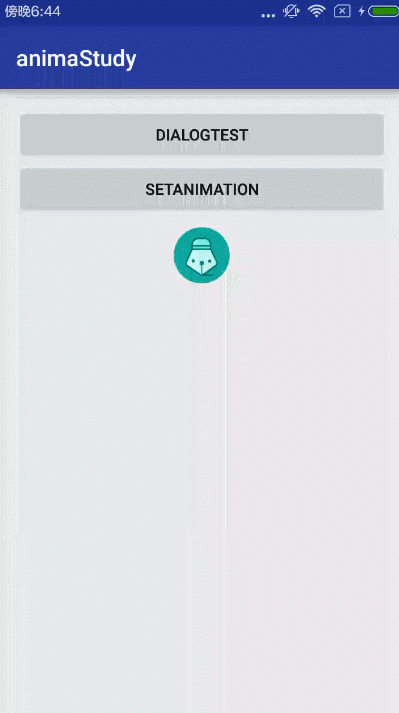android动画基础之Animation
2016-04-13 18:47
555 查看
概述
最近总结一下android的一些东西,毕竟基础不牢地动山摇。本篇主要涉及Animation,对Tween和Frame动画做些总结。Tween
Tween动画即补间动画,主要主持4种效果,缩放、透明度变化、旋转、平移,也可以组合起来使用(set/AnimationSet),在xml中对应的标签和java 代码中体现如下scale —— ScaleAnimation
alpha —— AlphaAnimation
rotate —— RotateAnimation
translate —— TranslateAnimation
set —— AnimationSet
一般在xml文件中配置Tween动画,它们的公有属性如下:
android:duration setDuration(long) 动画持续时间,以毫秒为单位
android:fillAfter setFillAfter(boolean) 如果设置为true,控件动画结束时,将保持动画最后时的状态
android:fillBefore setFillBefore(boolean) 如果设置为true,控件动画结束时,还原到开始动画前的状态
android:fillEnabled setFillEnabled(boolean) 与android:fillBefore 效果相同,都是在动画结束时,将控件还原到初始化状态
android:repeatCount setRepeatCount(int) 重复次数
android:repeatMode setRepeatMode(int) 重复类型,有reverse和restart两个值,取值为RESTART或 REVERSE,必须与repeatCount一起使用才能看到效果。因为这里的意义是重复的类型,即回放时的动作。
android:interpolator setInterpolator(Interpolator) 设定插值器,其实就是指定的动作效果,比如弹跳效果等
scale
scale标签是缩放动画,可以实现动态调控件尺寸的效果,有下面几个属性:android:fromXScale 起始的X方向上相对自身的缩放比例,浮点值,比如1.0代表自身无变化,0.5代表起始时缩小一倍,2.0代表放大一倍;
android:toXScale 结尾的X方向上相对自身的缩放比例,浮点值;
android:fromYScale 起始的Y方向上相对自身的缩放比例,浮点值,
android:toYScale 结尾的Y方向上相对自身的缩放比例,浮点值;
android:pivotX 缩放起点X轴坐标,可以是数值、百分数、百分数p 三种样式,比如 50、50%、50%p,当为数值时,表示在当前View的左上角,即原点处加上50px,做为起始缩放点;如果是50%,表示在当前控件的左上角加上自己宽度的50%做为起始点;如果是50%p,那么就是表示在当前的左上角加上父控件宽度的50%做为起始点x轴坐标。(具体意义,后面会举例演示)
android:pivotY 缩放起点Y轴坐标,取值及意义跟android:pivotX一样。
放到代码中,ScaleAnimation有下面几个构造函数:
ScaleAnimation(Context context, AttributeSet attrs)
ScaleAnimation(float fromX, float toX, float fromY, float toY)
ScaleAnimation(float fromX, float toX, float fromY, float toY, float pivotX, float pivotY)
ScaleAnimation(float fromX, float toX, float fromY, float toY, int pivotXType, float pivotXValue, int pivotYType, float pivotYValue)
alpha
alpha标签主要用来管理透明度:android:fromAlpha 动画开始的透明度,从0.0 –1.0 ,0.0表示全透明,1.0表示完全不透明
android:toAlpha 动画结束时的透明度,也是从0.0 –1.0 ,0.0表示全透明,1.0表示完全不透明
所对应的构造函数为:
AlphaAnimation(Context context, AttributeSet attrs) 同样,从本地XML加载动画,基本不用
AlphaAnimation(float fromAlpha, float toAlpha)
rotate
旋转标签Rotate标签所具有的XML属性有:
android:fromDegrees 开始旋转的角度位置,正值代表顺时针方向度数,负值代码逆时针方向度数
android:toDegrees 结束时旋转到的角度位置,正值代表顺时针方向度数,负值代码逆时针方向度数
android:pivotX 缩放起点X轴坐标,可以是数值、百分数、百分数p 三种样式,比如 50、50%、50%p,具体意义已在scale标签中讲述,这里就不再重讲
android:pivotY 缩放起点Y轴坐标,可以是数值、百分数、百分数p 三种样式,比如 50、50%、50%p
对应的构造函数有:
RotateAnimation(Context context, AttributeSet attrs) 从本地XML文档加载动画,同样,基本不用
RotateAnimation(float fromDegrees, float toDegrees)
RotateAnimation(float fromDegrees, float toDegrees, float pivotX, float pivotY)
RotateAnimation(float fromDegrees, float toDegrees, int pivotXType, float pivotXValue, int pivotYType, float pivotYValue)
translate
平移标签android:fromXDelta 起始点X轴坐标,可以是数值、百分数、百分数p 三种样式,比如 50、50%、50%p,具体意义已在scale标签中讲述,这里就不再重讲
android:fromYDelta 起始点Y轴从标,可以是数值、百分数、百分数p 三种样式;
android:toXDelta 结束点X轴坐标
android:toYDelta 结束点Y轴坐标
这些属性所对应的构造函数为:
TranslateAnimation(Context context, AttributeSet attrs) 同样,基本不用
TranslateAnimation(float fromXDelta, float toXDelta, float fromYDelta, float toYDelta)
TranslateAnimation(int fromXType, float fromXValue, int toXType, float toXValue, int fromYType, float fromYValue, int toYType, float toYValue)
插值器
用来定义动画速率如何变化AccelerateDecelerateInterpolator 在动画开始与介绍的地方速率改变比较慢,在中间的时候加速
AccelerateInterpolator 在动画开始的地方速率改变比较慢,然后开始加速
AnticipateInterpolator 开始的时候向后然后向前甩
AnticipateOvershootInterpolator 开始的时候向后然后向前甩一定值后返回最后的值
BounceInterpolator 动画结束的时候弹起
CycleInterpolator 动画循环播放特定的次数,速率改变沿着正弦曲线
DecelerateInterpolator 在动画开始的地方快然后慢
LinearInterpolator 以常量速率改变
OvershootInterpolator 向前甩一定值后再回到原来位置
使用
<?xml version="1.0" encoding="utf-8"?> <set xmlns:android="http://schemas.android.com/apk/res/android" android:duration="3000" android:fillAfter="true" > <alpha android:fromAlpha="0.0" android:toAlpha="1.0"/> <scale android:fromXScale="0.0" android:fromYScale="0.0" android:pivotX="50%" android:pivotY="50%" android:toXScale="1.4" android:toYScale="1.4"/> <rotate android:fromDegrees="0" android:pivotX="50%" android:pivotY="50%" android:toDegrees="720"/> <translate android:fromXDelta="0.0" android:fromYDelta="0" android:interpolator="@android:anim/accelerate_decelerate_interpolator" android:toXDelta="200" android:toYDelta="200"/> </set>
private ImageView ivShow;
private Animation setAnimation;
……
private void startSetnimation() {
setAnimation = AnimationUtils.loadAnimation(this, R.anim.setanimtion);
ivShow.startAnimation(setAnimation);
}
这里也对图片设置了点击监听,但是使用动画后的位置点击没有效果,但是点击原来位置的空白处仍有点击触发,这也体现了以前旧的动画的不足之处,就是属性并未改变,比如这里的监听,后面的属性动画正好解决了这一点。
Frame
其逐帧动画使用的还是比较多的,类似幻灯片方式来先编写好Drawable,然后代码中调用start()以及stop()开始或停止播放动画,当然我们也可以在Java代码中创建逐帧动画,关键标签为animation-list
<?xml version="1.0" encoding="utf-8"?> <animation-list xmlns:android="http://schemas.android.com/apk/res/android" android:oneshot="false"> <item android:drawable="@mipmap/progress_1" android:duration="200"/> <item android:drawable="@mipmap/progress_2" android:duration="200"/> <item android:drawable="@mipmap/progress_3" android:duration="200"/> <item android:drawable="@mipmap/progress_4" android:duration="200"/> <item android:drawable="@mipmap/progress_5" android:duration="200"/> <item android:drawable="@mipmap/progress_6" android:duration="200"/> <item android:drawable="@mipmap/progress_7" android:duration="200"/> <item android:drawable="@mipmap/progress_8" android:duration="60"/> </animation-list>
通常在很多自定义的view中使用这种方式,比如加载动画,有一些的转圈圈就是一帧帧动画
这个给出一个customprogressDialog
/*
* 自定义旋转对话框
*/
public class CustomProgressDialog extends Dialog {
private static CustomProgressDialog customProgressDialog = null;
public CustomProgressDialog(Context context) {
super(context);
}
public CustomProgressDialog(Context context, int theme) {
super(context, theme);
}
public static CustomProgressDialog createDialog(Context context) {
customProgressDialog = new CustomProgressDialog(context,
R.style.CustomProgressDialog);
customProgressDialog.setContentView(R.layout.customprogressdialog);
customProgressDialog.getWindow().getAttributes().gravity = Gravity.CENTER;
return customProgressDialog;
}
public void onWindowFocusChanged(boolean hasFocus) {
if (customProgressDialog == null) {
return;
}
ImageView imageView = (ImageView) customProgressDialog
.findViewById(R.id.loadingImageView);
AnimationDrawable animationDrawable = (AnimationDrawable) imageView
.getBackground();
animationDrawable.start();
}
public CustomProgressDialog setTitile(String strTitle) {
return customProgressDialog;
}
public CustomProgressDialog setMessage(String strMessage) {
TextView tvMsg = (TextView) customProgressDialog
.findViewById(R.id.id_tv_loadingmsg);
if (tvMsg != null) {
tvMsg.setText(strMessage);
}
return customProgressDialog;
}
}其中
customProgressDialog.setContentView(R.layout.customprogressdialog);的布局文件
<?xml version="1.0" encoding="utf-8"?> <LinearLayout xmlns:android="http://schemas.android.com/apk/res/android" android:layout_width="fill_parent" android:layout_height="fill_parent" android:orientation="horizontal" > <ImageView android:id="@+id/loadingImageView" android:layout_width="wrap_content" android:layout_height="wrap_content" android:background="@anim/progress_round" /> <TextView android:id="@+id/id_tv_loadingmsg" android:layout_width="wrap_content" android:layout_height="wrap_content" android:layout_gravity="center_vertical" android:textSize="20dp" /> </LinearLayout>
imageView使用到了anim中的定义的帧动画

这个dialog的转圈就是通过8张图片通过帧动画来处理的。
代码传送门点击
参考:
http://blog.csdn.net/harvic880925/article/details/39996643
相关文章推荐
- 使用C++实现JNI接口需要注意的事项
- Android IPC进程间通讯机制
- Android Manifest 用法
- [转载]Activity中ConfigChanges属性的用法
- Android之获取手机上的图片和视频缩略图thumbnails
- Android之使用Http协议实现文件上传功能
- Android学习笔记(二九):嵌入浏览器
- android string.xml文件中的整型和string型代替
- i-jetty环境搭配与编译
- android之定时器AlarmManager
- android wifi 无线调试
- Android Native 绘图方法
- Android java 与 javascript互访(相互调用)的方法例子
- android 代码实现控件之间的间距
- android FragmentPagerAdapter的“标准”配置
- Android"解决"onTouch和onClick的冲突问题
- android:installLocation简析
- android searchView的关闭事件
- SourceProvider.getJniDirectories
